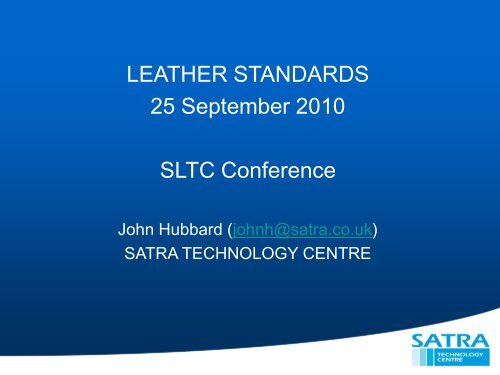View PowerPoint presentation as pdf - SLTC. Society of Leather ...
View PowerPoint presentation as pdf - SLTC. Society of Leather ...
View PowerPoint presentation as pdf - SLTC. Society of Leather ...
Create successful ePaper yourself
Turn your PDF publications into a flip-book with our unique Google optimized e-Paper software.
LEATHER STANDARDS<br />
25 September 2010<br />
<strong>SLTC</strong> Conference<br />
John Hubbard (johnh@satra.co.uk)<br />
SATRA TECHNOLOGY CENTRE
John Hubbard<br />
• BSc (Hons) Colour Chemistry & Dyeing –<br />
University <strong>of</strong> Leeds 1990<br />
• Chartered Chemist (CChem, MRSC)<br />
• Team Leader – Research SATRA Technology<br />
Centre (2007- Present)<br />
• SATRA Chemical & Analytical Technology<br />
Group (1996-2007)<br />
• Coal Research Establishment (1990-6)<br />
• <strong>SLTC</strong> Technical Co-ordinator (since 2008)
Outline<br />
• Why do we have standards<br />
• British Standard Institute<br />
• European Standards (CEN)<br />
• International Standards (ISO)
Why do we have standards<br />
• Standards allow direct comparison<br />
between like materials<br />
• Used by manufacturers, buyers,<br />
laboratories and government<br />
• Some standards are mandatory others<br />
provide guidelines for fitness for purpose
Specification or Test Method<br />
• Specifications list a set <strong>of</strong> performance<br />
parameters for a specific purpose (e.g<br />
Upholstery leathers BS EN 13336)<br />
• Test methods do not contain p<strong>as</strong>s fail<br />
criteria (BS EN ISO 4045)
National Standards Bodies (NSBs)<br />
• BSI – UK<br />
• AFNOR – France<br />
• AENOR - Spain<br />
• DIN – Germany<br />
• UNI – Italy<br />
• ASTM – America
British Standards Institute<br />
• Founded in 1901<br />
• Royal Charter<br />
• Many international<br />
standards started <strong>as</strong><br />
British Standards<br />
(ISO14001)
The Role <strong>of</strong> <strong>SLTC</strong><br />
• Many <strong>of</strong> the European tests methods for leather<br />
have been developed from <strong>SLTC</strong> <strong>of</strong>ficial<br />
methods<br />
• European methods are dual numbered with<br />
IUC/IUP methods<br />
• <strong>SLTC</strong> h<strong>as</strong> a seat on the UK mirror committee
TCI/69<br />
• National Mirror Committee for <strong>Leather</strong>, Footwear<br />
and Coated Fabrics<br />
• Chair – Christine Ohren-Bird<br />
• Three Sub-commitees<br />
• External secretariat - SATRA
TCI/100<br />
TCI/100<br />
Co-ordination<br />
committee<br />
for apparel & textiles<br />
TCI/24<br />
Physical Testing<br />
<strong>of</strong> Textiles<br />
TCI/66<br />
Clothing<br />
TCI/69<br />
Footwear <strong>Leather</strong> &<br />
Coated Fabrics<br />
TCI/80<br />
Chemical Testing<br />
<strong>of</strong> textiles<br />
TCI/81<br />
Colour F<strong>as</strong>tness &<br />
Colour Me<strong>as</strong>urement<br />
TCI/82<br />
Laundering
Role <strong>of</strong> the National Committee<br />
• Administer British Standards<br />
• Propose UK view on European and<br />
International standards<br />
• Select delegates and experts to attend<br />
CEN & ISO meetings
European Committees<br />
• TC289 <strong>Leather</strong><br />
• TC309 Footwear<br />
• TC248 Textiles<br />
• TC161 Safety<br />
Footwear
TC289<br />
• Four Working Groups<br />
WG1<br />
WG2<br />
WG3<br />
WG4<br />
Chemical Testing<br />
Physical Testing<br />
Definitions and Terms<br />
Furniture <strong>Leather</strong><br />
• WG 2 h<strong>as</strong> UK chair Mike Wilson (SATRA)
TC309<br />
• Two Working groups<br />
WG1<br />
WG2<br />
Physical Test Methods<br />
Chemical Test Methods<br />
• Meets in conjunction with International<br />
Committee (ISO TC216)
ISO Committees<br />
• Recognised beyond<br />
the borders <strong>of</strong> Europe<br />
• BSI w<strong>as</strong> founder<br />
member in 1946<br />
• H<strong>as</strong> agreement with<br />
CEN on dual adoption<br />
<strong>of</strong> standards
Vienna Agreement<br />
• Signed in 1991 between CEN & ISO<br />
• Avoids duplication <strong>of</strong> standardisation work<br />
• Allows international access to European standardisation<br />
for non-CEN countries<br />
• Unique adoption procedure between CEN & ISO<br />
• Withdrawal <strong>of</strong> conficting standards
ISO120<br />
• Separate ISO leather committee<br />
• Secretariat held by India<br />
• UK re<strong>presentation</strong> <strong>of</strong> ISO120<br />
• Meets separately from CEN289
<strong>SLTC</strong> Technical Co-ordination<br />
Committee<br />
• Can independently revise and update <strong>SLTC</strong><br />
<strong>of</strong>ficial methods<br />
• Technical Co-ordinator<br />
• Member involvement<br />
• Industry use/acceptance and requirements


